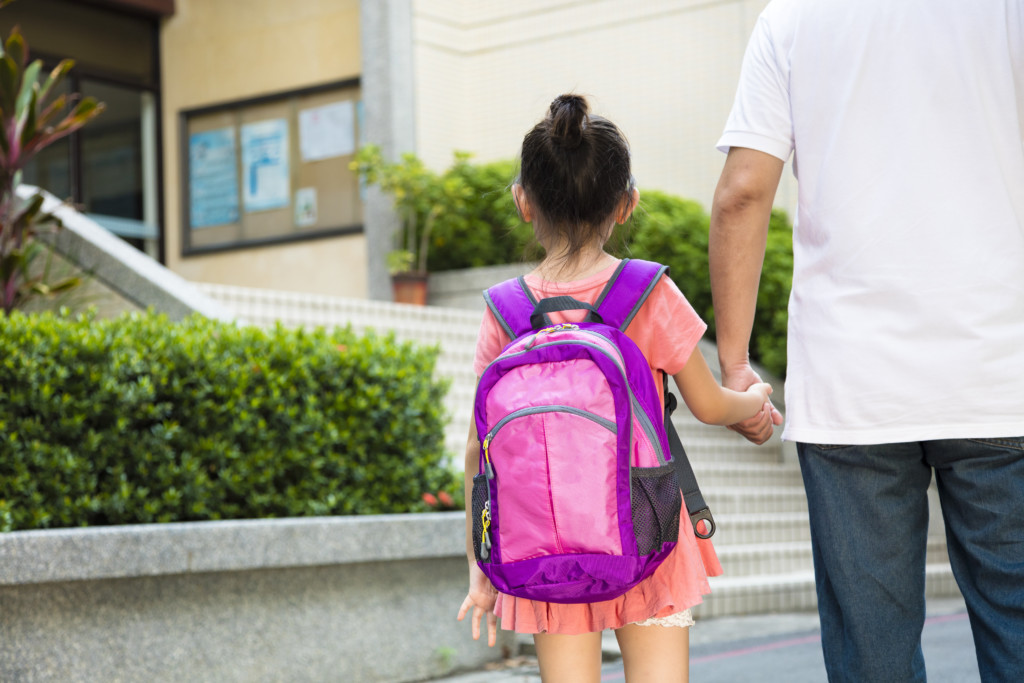 The Florida Tax Credit Scholarship served 85,612 low- and middle-income students last year, according to a new report from the Florida Department of Education. The program funded $568.8 million in scholarships, worth an average of around $7,300, during the 2021-22 school year.
The Florida Tax Credit Scholarship served 85,612 low- and middle-income students last year, according to a new report from the Florida Department of Education. The program funded $568.8 million in scholarships, worth an average of around $7,300, during the 2021-22 school year.
Step Up For Students, which hosts this blog, served 83,643 students, or 97.7 percent of the total.
Of the students, 38.9% were Hispanic, 28.1% Black, 27.2% white, and 5.8 % “other.”
During the 2021-22 school year 1,990 private schools in 65 of the 67 counties participated in the FTC program. According to the Department, 65.1% of the private schools reported a religious affiliation while 34.9% reported no affiliation. However, 81.4% of students attended a religious-affiliated private school.
Miami-Dade County enrolled the most students with 19,454 in the program, followed by Broward (8,297), Orange (7,472) and Duval (6,254) counties. Calhoun and Liberty counties enrolled no students in the scholarship program.
Created by the state Legislature in 2001, the Florida Tax Credit Scholarship is funded by private corporate contributions. Donors receive a dollar-for-dollar credit on their corporate taxes. Last year the program was capped at $873 million in tax credits.
For 2022-23, the tax credit cap has been raised to more than $1 billion. Step Up for Students so far has 90,518 students enrolled in the program this year. Nearly 1.2 million scholarships have been awarded through the program since 2002.
Florida Tax Credit scholarships are still available for the 2022-23 school year. Parents and guardians may apply for a scholarship for free through Step Up For Students here.

Tae Harvey, 13, attends a homeschool co-op in rural Williston, Florida, one day a week and works one-on-one with co-op founder Tracy Kirby for several hours on another day. Tae’s mom, Misty Dodd, says she’s seen “a 200% difference” in her daughter since she started attending the co-op..
WILLISTON, Fla. – When Misty Dodd’s daughter Taelyr was in third grade, her teachers told Dodd that “Tae” needed to be in a school with more rigor. Tae, now 13, was enrolled in the neighborhood school’s gifted program. But she was making straight A’s without breaking a sweat, and so bored, she was racking up demerits for being too chatty.
The teachers suggested a school in Gainesville. But for Dodd, it wasn’t an option. With traffic, it was 45 minutes to an hour from their home in Williston, a town of 2,700 surrounded by pine forest and pasture. And Dodd, a single mom, works 70 hours a week to make ends meet.
“I was embarrassed and frustrated,” said Dodd, who still cries at the recollection five years later. “I was thinking my daughter is going to get lost. What if she loses interest because it’s not challenging enough?”
“I was thinking, ‘I’m going to let her down,’ ” Dodd continued. “I thought, ‘She’s not going to get the education she deserves.’ "
Thankfully, the story of Tae and her mom has an almost perfect ending.
Almost.
Dodd found Tracy Kirby, a former public school teacher who started a home-school co-op on a farm full of trains. Kirby is now Tae’s teacher.
Tae attends the co-op one day a week, then works with Kirby one-on-one, in person, for several hours on another day. Kirby assigns Tae work for the week, and Tae touches base by phone or online as often as necessary.
For Tae and her mom, the arrangement works.
“What Mrs. Kirby does is amazing, and Tae loves it,” Dodd said. “I know I can trust Mrs. Kirby. There’s a 200 percent difference between now and before.”
“The main difference now is, I’m challenged,” Tae said. “Academically, there’s always something for me to do. And if there’s something else I want to do, I can ask, and Ms. Tracy can work it into the curriculum.”
By age, Tae is an eighth grader. But in most of her subjects, she’s performing at a ninth grade level or higher.
The only downside – and it’s a serious one – is cost.
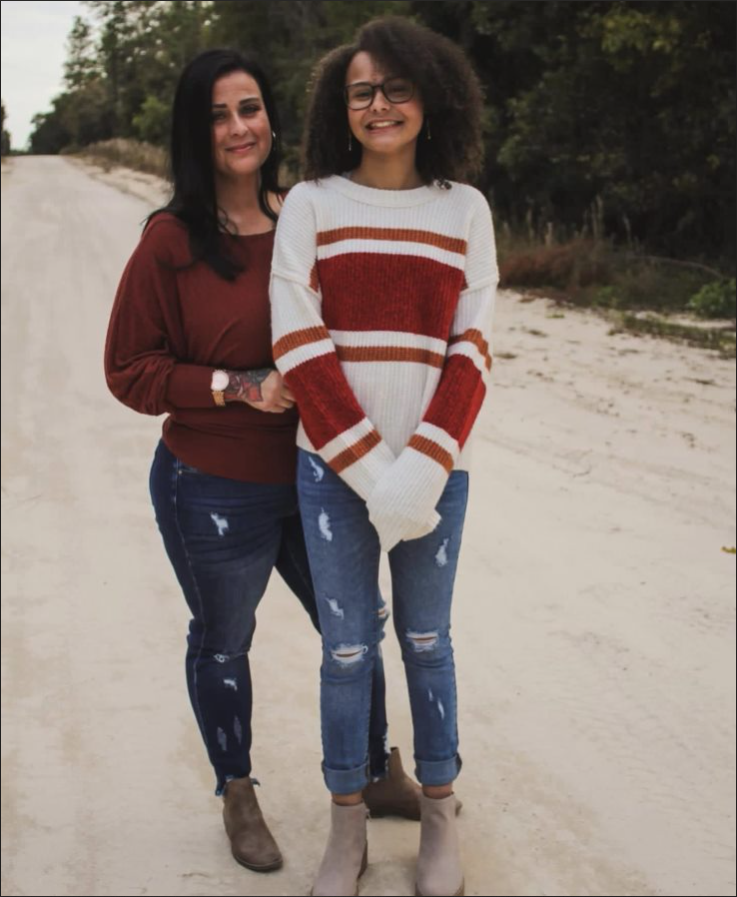
Misty Dodd and her daughter, Tae
Dodd works two jobs – one as a clerk at the Florida Department of Motor Vehicles; the other as a waitress. It’s not easy paying for Tae’s education. Kirby doesn’t charge for the co-op programming, but there is a fee for the 1-on-1 tutoring. Dodd must also pay for books, a laptop, a printer, and other supplies.
A state-funded education savings account (ESA) that would pay for those expenses, and other learning supplements for Tae, would be “incredible,” Dodd said. “I work two jobs in part to pay for that. A scholarship would be a blessing.”
Florida does have an ESA. It’s popular and successful. But it’s limited to students with certain special needs. Tae is not eligible.
Florida also has the most expansive private school choice programs in the nation. But unlike ESAs, which can be used for a variety of services and providers, traditional school choice scholarships are limited to private school tuition. Dodd could qualify for a traditional scholarship, where eligibility is determined by family income. But it wouldn’t do Tae any good.
(Both the ESA and the income-based scholarships are administered by Step Up For Students, which hosts this blog.)
Dodd said she never considered private school for Tae because Kirby’s approach is so good.
Kirby tailors the curriculum to fit Tae’s needs and interests. Tae takes many of her core academic classes through Florida Virtual School. She accesses electives through other online platforms (everything from typing to logic to archaeology). Kirby coordinates all of it, then tops it off with her own guidance and instruction and an emphasis on project-based learning.
For example, Tae is passionate about writing. So Kirby frequently gives her writing assignments, from essays to short stories. One time, Kirby asked Tae to study the past winners of a Florida speech contest. She wanted Tae to learn the techniques behind good speeches and to work on her public speaking skills.
“This propelled her to become an expert and figure out what made dynamic speeches,” Kirby said. “She doesn’t stop until she discovers the why.”
“I continuously find myself in shock over her writing,” Kirby continued. “She has a sharp imagination and adds humor. She can also be serious and argue a point.”
Tae is organized and driven. On her own, she read “The Diary of Anne Frank” in third grade and “The Yearling” in fourth grade. In fifth grade, Kirby gave Tae a thesaurus. She also showed Tae how she took notes in college, and Tae used Kirby’s system as a guide to create her own, better system.
“She’s unlike any student I have seen in all my years of teaching,” Kirby said. “The effort she puts in on her own is remarkable.”
Finances, though, are putting limits on Tae’s pursuits.
Tae is fascinated with forensic science and criminal psychology. Kirby said she’d love to look for STEM kits and online programs that mesh with Tae’s interests, and perhaps enroll Tae part time in a school that specializes in crime scene investigations.
“She’d love it,” Kirby said. “She’d be a little mad scientist.”
But all of that costs money Dodd doesn’t have.
An ESA would change that.
If it’s akin in value to the state’s school choice scholarships, it would cost taxpayers far less than per-pupil spending in Florida district schools. And for students like Tae, the return on investment would be invaluable.
Without Kirby, Dodd said, Tae might have become self-conscious about her intellectual interests and retreated into a shell. “She might have gone backwards,” Dodd said.
Kirby said other students have come to her co-op in that shell, shaped by past schooling experiences. In a different setting, they blossom into self-motivated learners like Tae.
If the state’s scholarships offered more flexibility, more students could access those environments.
For Tae and her mom, it’d be perfect.
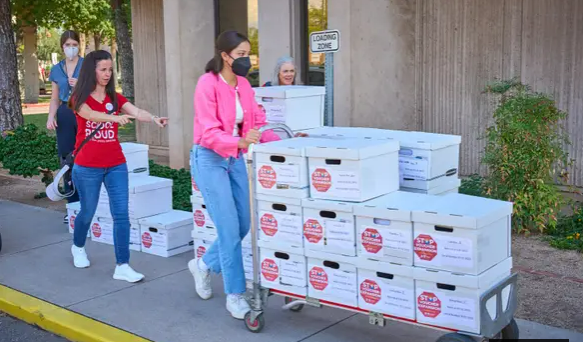
Members of Save Our Schools cart boxes of signed petitions to a storage room at the Arizona Capitol in Phoenix last week. The petition drive fell short of minimum signature requirements, so the program will roll out as planned. PHOTO: Alex Gould/The Republic
School choice expansion in Arizona became official last week with an announcement from Secretary of State Katie Hobbs that school choice opponents would not meet the minimum signature requirements to stop the program and send it to the ballot.
Hobbs, a Democrat running for governor who opposed the plan, said her office’s review of signatures came up short of the nearly 119,000 that were needed. Arizona’s Empowerment Scholarship Accounts Program now will be available to every student in the state.
Congratulatory remarks from school choice advocates, including leaders at the American Federation for Children, soon followed.
Statement from American Federation for Children CEO Tommy Schultz:
“Arizona is now the national standard-bearer for education freedom, and we’re thrilled to have stood behind Arizona parents and advocates for years as they achieved this resounding victory. Elected officials in every state should look to Arizona leaders like Gov. Ducey, Rep. Toma, and others for their political courage and look to follow their example.”
Statement from Arizona State Director of the American Federation for Children Steve Smith:
“Today marks the culmination of what thousands of families across the state have spent years fighting for. After several exceedingly challenging years with learning loss and grown-up politics getting in the way, the students have won. We are thrilled to know that all 1.1 million Arizona students will now have access to unlimited educational opportunities that school choice brings.”
Corey DeAngelis, a senior fellow at the federation, weighted in on Twitter, writing, “All Arizona families can now apply to take their children’s state-funded education dollars to the education providers of their choosing.”
Arizona Republican Gov. Doug Ducey, who championed the plan and signed it into law in July, also celebrated on Twitter, saying, “Let’s roll!” and “Parents prevail.”
Arizona’s education savings account program is now available for 1.1 million eligible families across the state, making Arizona the broadest school choice state in the nation. The program allows parents to receive scholarships by redirecting their current education tax dollars for expenses, such as private school tuition, resources for schooling at home, online curriculum, education therapies, tutoring, and more.
The ESA amount is expected to be approximately $7,000 per student per year.
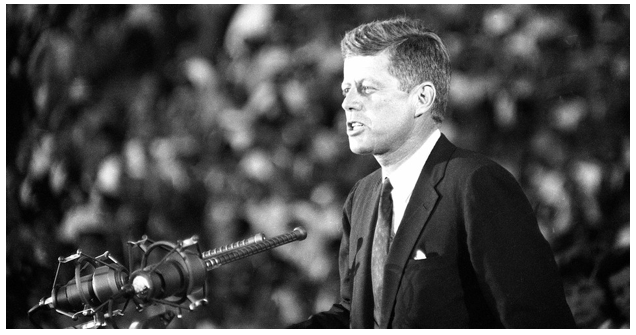 “Some would say that those struggles are all over, that all the horizons have been explored, that all the battles have been won, that there is no longer an American frontier. But I trust that no one in this assemblage would agree with that sentiment; for the problems are not all solved, and the battles are not all won; and we stand today on the edge of a New Frontier … ” – President John F. Kennedy
“Some would say that those struggles are all over, that all the horizons have been explored, that all the battles have been won, that there is no longer an American frontier. But I trust that no one in this assemblage would agree with that sentiment; for the problems are not all solved, and the battles are not all won; and we stand today on the edge of a New Frontier … ” – President John F. Kennedy
“Now this is not the end. It is not even the beginning of the end. But it is, perhaps, the end of the beginning.” – Winston Churchill
Those of us who believe in pluralism, diversity and variety in K-12 education have been thrilled since word leaked that Arizona choice opponents failed in their effort to kill the state’s Empowerment Scholarship Account Program expansion.
It’s now official: We have a choice program available to all school age children. This is a great achievement. We should celebrate and face future challenges with growing strength and enthusiasm.
Arizona’s program, and others like it perhaps to soon follow, are the next rather than the final milestone. The new frontier of the choice movement dawns on the horizon and will require still more sacrifice and toil to achieve.
That proposition: voluntary association and exchange should become a core principle of public education by putting all K-12 funding into parent directed accounts.
Much remains to debate and decide about such a system. How much extra funding should be given to different sorts of students? We’ve been using state K-12 funding formula weights as a default, but they aren’t stone tablets brought down from Mount Sinai.
What sort of supportive infrastructure in terms of information about service providers and navigation for parents should exist? What sort of technologies and practices are necessary to operate at truly universal scale?
I have opinions on these questions, but I don’t have answers. We are in the early stages of learning by doing in account-based education, which has been going on for barely over a decade at a small but growing scale. It will take toil, sweat, tears, and time to learn what we need to know.
Nevertheless, attendance boundaries and school assignment by default deserve a place in the dustbin of history right alongside other terrible practices of the past such as segregating schools by race and denying children with disabilities access to public schools.
With a great deal of hard work, future Americans may learn of all of these things, wince in disbelief, and ask their elders how it was possible that any of these horrible practices actually existed.
Purchased privilege reigns over our current K-12 system with an iron fist. Advantaged families buy homes zoned for high performing schools. They pay higher school taxes than most anyone in the world. They spend thousands of dollars annually on enrichment activities – tutors, camps, private lessons, college entrance exam test preparation, club sports and more.
Their reward for all of this investment: avoiding catastrophe but losing to Estonia on average.
A much grimmer prospect awaits American families who cannot afford hundreds of thousands in mortgage debt and thousands in annual enrichment spending. Locked out of high demand districts, unable to afford private school tuition, the failed promise of American public education has contributed to generational cycles of poverty.
Sen. John F. Kennedy’s acceptance speech in securing the Democratic nomination contains additional instruction for us today:
“We are not here to curse the darkness. We are here to light a candle. As Winston Churchill said on taking office some twenty years ago, ‘If we open a quarrel between the present and the past, we shall be in danger of losing the future.’ Today our concern must be with that future. For the world is changing. The old era is ending. The old ways will not do.”
Those words, spoken in 1960, roar into the present. The old ways in American K-12 education will not do. We indeed are in danger of losing the future. We cannot afford to mass produce illiteracy, innumeracy, and civic ignorance.
The future of American education must be pluralistic, diverse, and varied. We cannot afford to diminish potential by segregating with lines. Public funding is guaranteed in state constitutions, but there is no reason to structure the enterprise to rob families of agency and dignity.
It’s still early yet. Much work remains undone, many battles lie ahead. Nevertheless, the day is coming when our K-12 policies will respect the dignity of families to exercise autonomy in schooling. When that day comes, we will set the education default at families exercising their rights as free people.
For decades, we have claimed that minds are a terrible thing to waste. It is long past time to have our actions match our words. The edge of a new frontier of liberty lies within the reach of this generation.
We’ve all cursed the darkness long enough. Let us turn and light a torch of liberty.

"I don't know who you are. I don't know what you want. If you are looking for ransom, I can tell you I don't have money, but what I do have are a very particular set of skills. Skills I have acquired over a very long career. Skills that make me a nightmare for people like you. If you let my daughter go now, that'll be the end of it. I will not look for you, I will not pursue you, but if you don't, I will look for you, I will find you, and I will kill you." — Liam Neeson
Arizona’s passage of universal ESAs leads to the question, “What’s next?” Some feel concerned that any number of rando grifter types will attempt to open private schools. Perhaps so, but then they will be snuffed out by an education sector that has developed a very particular set of skills acquired over a very long period of competitive K-12 policy. They will look for the students of grifter schools, they will find them, and they will kill schools that fail to satisfy parents. It’s all happened before, and it will all happen again. Saddle up; keep your cool; give it time. The ending here is as predictable as Taken.
Arizona started down the road to K-12 choice in 1994 with a liberal charter school law and a law forbidding open enrollment tuition. In 1997, lawmakers passed the first scholarship tax credit program, which was expanded multiple times. In 2011, Arizona lawmakers passed the first Education Savings Account program.
Most Phoenix area K-8 students do not attend their zoned district schools. District schools both lose and gain enrollment in the process. Low demand charter schools tend to fold quickly. Low demand district schools often go through a radioactive half-life as mostly empty zombie schools, but eventually school boards close or consolidate them. Zombie schools drain resources from teacher compensation, but school boards are famously cowardly when it comes to making painful adjustments opposed by angry mobs of parents. More district than charter students are affected by school closures overall, but the process grinds on year to year.
The survivors of 28 years of this process have developed a very particular set of skills. Numbered among these: driving the nation’s highest rate of academic growth as documented by the Stanford Educational Opportunity project. Below is a chart showing the rate of academic growth for economically disadvantaged students by state:
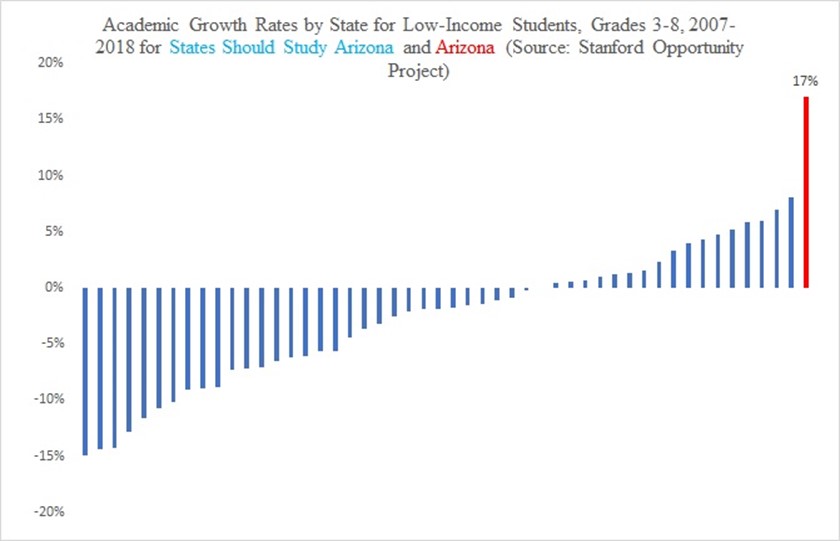
What is the “very particular set of skills” that makes me confident that Arizona educators will crush grifters? Three decades of working with families to figure out what they want for starters. Advanced experience dealing with real-estate, zoning and debt markets and recruiting teachers and training them up to achieve the above results. If you can imagine a type of school, an Arizona charter or district has probably either already tried it, discarded it, or else is running it. Demand discovery has been underway for almost three decades. The ESA program creates a new tool for these and other educators to employ.
I have never seen “Taken,” but put me down but as “all-in” on Liam Neeson putting down the bad guys. It will take time. There will be complaints and headlines. New models that satisfy parents will emerge. For decades now if you wanted to open a school in Arizona you had to bring an A-game. Nothing has changed on that front.
Arizona educators have dispatched grifters before. Watch them do it again. I can’t wait to see what America’s apex educators make with their new tool.
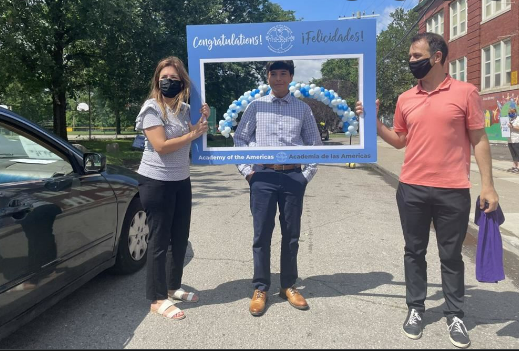
Academy of the Americas is a public pre-kindergarten through high school of Detroit Public Schools, with its primary school campus located in the former St. Hedwig School in southwest Detroit. It offers a Spanish-English bilingual program.
Editor’s note: This article appeared last week on thecentersquare.com.
Hispanic parents nationally are increasingly investigating alternatives to traditional public schools, according to a survey released this week by Conoce tus Opciones Escolares.
COE reported 59% of Hispanic parents surveyed responded they were considering other education options for at least one child from each family, whereas 52% of all parents – Hispanic and otherwise – responded likewise.
COE describes itself as a sister project of the National School Choice Awareness Foundation. Krissia Campos Spivey, COE project director, told The Center Square the dropout rate for Hispanic students is 65% higher than it is for white students. She added the pandemic only served to exacerbate education issues for minority students as well as for students of every race.
“The last two years have made the racial achievement gap even worse,” Spivey said.
Other statistics supporting Spivey’s assertion include Michigan’s most recent M-STEP scores, which reveal only 9% of Detroit third graders tested last spring are reading at or above grade level. Out of 3,722 students, 910 (24%) were deemed eligible for third-grade retention, but only 107 – less than 3% – were actually held back. Statewide, 5,700 students (5.8%) were eligible for third-grade retention, up from 4.8% prior to the pandemic.
COE surveyed 1,228 Hispanic or Latino parents of children between the ages of 5 and 18. Nineteen questions were asked, prompting 49% of respondents to say they were considering switching to nontraditional schools due to their students’ learning disruptions as a result of the pandemic; 56% responded they desired a higher quality of education for their children; 49% noted their concerns over bullying and school safety; and 24% answered they had concerns over school curriculum.
To continue reading, click here.
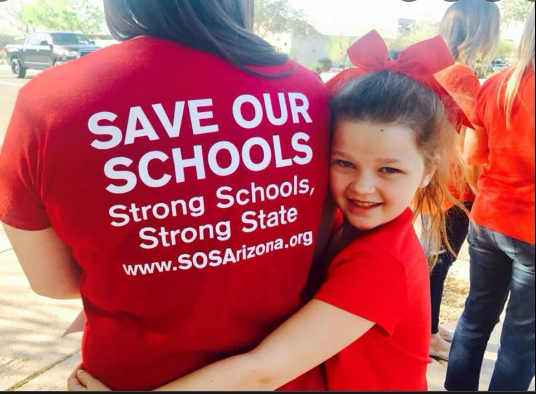
Anti-education choice group Save Our Schools Arizona gathered enough signatures to put a 2018 effort of state lawmakers seeking to expand education savings account eligibility up for referendum.
Editor’s note: This article appeared Friday on azmirror.com.
Teachers and public school advocates on Friday submitted nearly 142,000 petition signatures to block the new universal school voucher program that was set to go into effect Friday and let voters decide its fate in 2024.
Save Our Schools Arizona PAC said it gathered 141,714 signatures to give voters the chance to weigh in on the expansion of the Empowerment Scholarship Account program, the formal name of the voucher system.
Whether voters will get that chance remains to be seen. The signatures represent almost 23,000 more than needed to refer the matter to the ballot, but state and county elections officials will inevitably whittle that number down when they verify the petitions comply with legal requirements and that the signers are registered voters.
And then there will be a legal challenge from school-choice backers. Arizona law allows opponents of citizen initiatives or referendums, like this one, to challenge the signatures in court. In the past decade, GOP lawmakers — with backing from big corporate interests upset that voters have approved minimum wage hikes and tax increases — have made it easier for challengers to disqualify large swaths of petition signatures.
If, after all that, the referendum has at least 118,823 valid signatures, the ESA expansion will be blocked and voters will have their say in November 2024. If the effort has too few signatures, the expansion will immediately go into effect.
Until all that happens, the law will remain blocked.
To continue reading, click here.
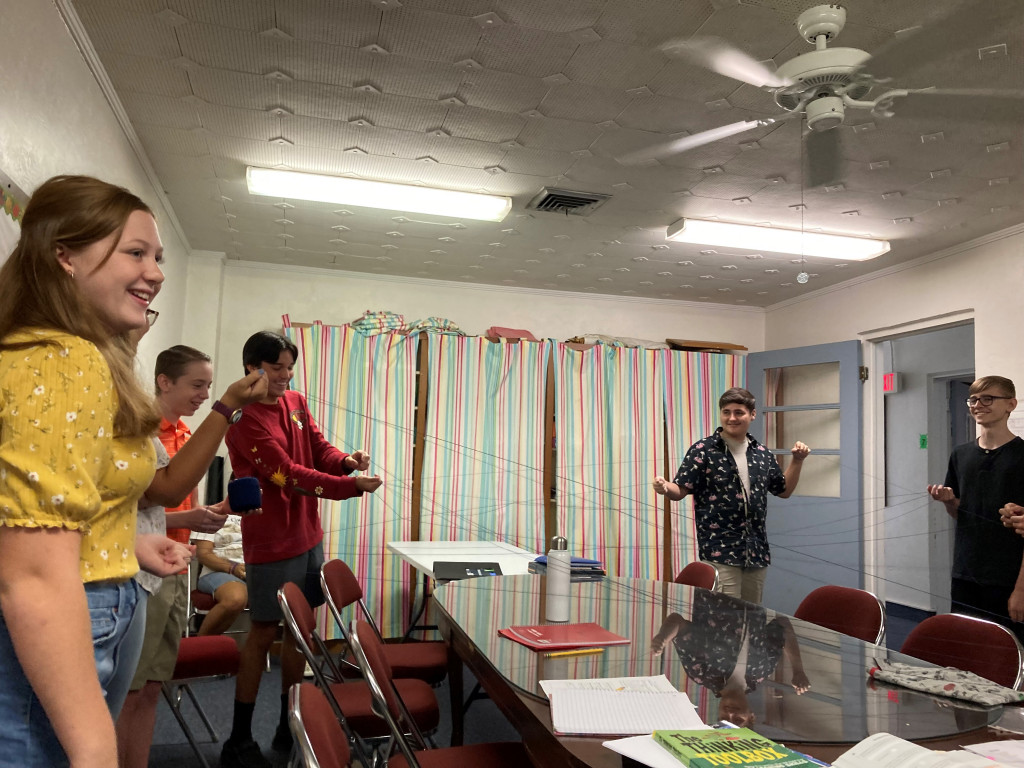
Students who are part of the new Hardee Cooperative Learning Center in Wauchula, Florida, participate in an exercise designed by co-op co-founder and director Sandra Shoffner to give them confidence speaking in public while exploring how much they have in common with each other.
WAUCHULA, Fla. – Sandra Shoffner dreamed of starting a homeschool co-op, but she never imagined the reception it would get when it finally happened.
Dozens of parents attended the first open house last month. They enrolled more than 50 kids for the first semester. And so many signed up for the second semester, there’s a waiting list.
“That night, I was just in awe. I’m still in awe,” said Shoffner, a mother of four with degrees in education. “It was surreal and fantastic. I was up there with the mic, literally shaking.”
“The turnout told me the need was insane.”
Home education was on the rise before the pandemic, then skyrocketed because of it. And it’s clear from the new Hardee Cooperative Learning Center in Wauchula, population 4,990, that the movement isn’t limited to cities and suburbs.
Hardee County, 70 miles from Tampa, is a patchwork of citrus groves, cattle ranches and phosphate mines.
A decade ago, it had 118 homeschoolers. Last year, it had 290.
Parents in the co-op say it’s even more important for rural communities to have learning options, because there are so few traditional schools, public or private. The expansion of co-ops, high-quality virtual providers and state-funded education savings accounts (ESAs) – which are more flexible than traditional school choice scholarships – are helping to make home education in rural areas even more viable.
“Bigger communities have a lot of options,” said parent Chelsea Green, who lives in another sprawling rural county next to Hardee. “We don’t.”
Green said she decided to homeschool her children, Tenley, 8, and Railan, 7, after realizing during the pandemic that she could actually do it. Tenley, who has ADHD, chafed under the rigid structure of a neighborhood school.
“It’s more like a rat race,” said Green, a former paraprofessional for district schools. “You have this time to do this, and this time to do that. My daughter isn’t good with a time schedule like that.”
With homeschooling, Tenley is less stressed and more engaged. She no longer needs as much of the ADHD medication that Green has never been comfortable giving her.
Wauchula isn’t an outlier.
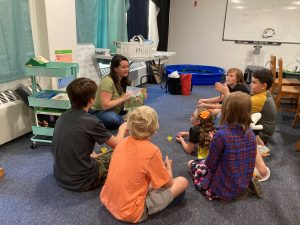
Interest in the Hardee Cooperative Learning Center has exceeded expectations of co-founder and director Sandra Shoffner. More than 50 families signed up for the first semester and there’s a waiting list for the second semester.
The number of homeschool students in Florida’s 30 rural counties rose from 6,201 in 2011-12 to 10,207 last year. The sector keeps growing despite an explosion in school choice options, even in rural areas, and without the state support that’s helping those other options.
In raw numbers, homeschooling growth in rural Florida outpaces the growth in charter schools (from 2,673 students to 5,356 students in those counties over that same span) and it’s neck-in-neck with private schools (6,450 to 10,965). As but one manifestation of the trend, it’s easy to find other new co-ops that are thriving off the beaten path, like this one and this one.
Homeschooling would get another boost if Florida’s traditional school choice scholarships offered more flexibility like its ESAs. ESAs can be used for private schools or home schooling, but at present only students with special needs are eligible. In Florida’s rural counties last year, 791 students used them. (The ESAs are officially called the Family Empowerment Scholarship for Students with Unique Abilities. They’re administered by nonprofits like Step Up For Students, which hosts this blog.)
Shoffner’s son Elliott, who is 7 and on the autism spectrum, is one of those ESA students.
Shoffner works part time as executive director of the Hardee County Friends of the Library, and has degrees in elementary education and special education. She began homeschooling almost a decade ago with her two oldest children.
The dream of a co-op followed.
“It’s important for the adults as much as the kids,” Shoffner said. “I wanted that community with other adults with similar interests.”
Shoffner knew homeschool parents could feel a little isolated, especially in a small town. She knew they’d appreciate connecting with other parents while their kids got opportunities to learn from other teachers. So, a few months ago, she and a handful of other DIY homeschool moms decided to give it a go.
The Hardee Cooperative Learning Center is using space in a church. It’s offering 16 classes one day a week for students ages 3 to 19. Seven teachers, all of them parents, are teaching everything from geography and elementary engineering to creative writing and arts and crafts. Shoffner teaches four classes, including Plants 101 and Debate.
One recent Monday, she went over the difference between fact and opinion to the eight teens in her debate class, and explained “red herring” and “ad hominem attack.” She also led an exercise where the students took turns holding a ball of yarn and listing things they liked until another student said, “Me too.” Then they held the thread while tossing the yarn to the other student, who repeated the drill. The point was to 1) practice speaking in public, and 2) to see, as the yarn formed a web, how much everyone had in common.
For homework, Shoffner asked the students to find a partner and choose from one of two topics: The death penalty or legalizing marijuana. She gave them a week to prepare to debate either the pros or cons.
Where the new co-op heads is up to the participating families.
More classes? Different classes? More and/or different days of the week? How about a seasoned math instructor?
The beauty of the co-op is its flexibility and responsiveness.
“What the parents want is absolutely going to shape where this goes,” Shoffner said. “We’re parent led.”
Shoffner said the Hardee Cooperative Learning Center is not faith-based, to distinguish it from other co-ops in the area, although it does offer some Bible-based classes.
It’s also committed to including any family that wants in.
Shoffner said she has been a lifelong advocate for inclusion for persons with special needs, stemming from a sister who is severely intellectually disabled.
“I don’t know how I can fight for inclusion for kids with special needs, then tell someone else I won’t include them,” she said.
Homeschool parents are grateful for the new co-op.
Lisa Dickey said her son, Laremy, 11, was in neighborhood schools through third grade. He struggled academically after several emotional events, including a fire that destroyed the family’s house and led them to move to a different part of the county and a different zoned school.
Dickey is a stay-at-home mom whose husband works for the Mosaic phosphate company. She said she wasn’t sure, at first, if she could homeschool adequately. But Laremy is taking his core academic classes through Florida Virtual School – which he loves – and she found support from other homeschool families.
The co-op is a nice complement, she said. The team building and character building classes are especially good, she said. And the co-op gives Laremy an opportunity to interact and have fun with other students.
“If he had stayed in public school, he would have fallen further behind,” Dickey said. “It’s good to have that choice.”
Especially, Shoffner said, in a rural area.
“We’ve had one option, one way, for so long,” Shoffner said. “Now we have many options. And people want them.”
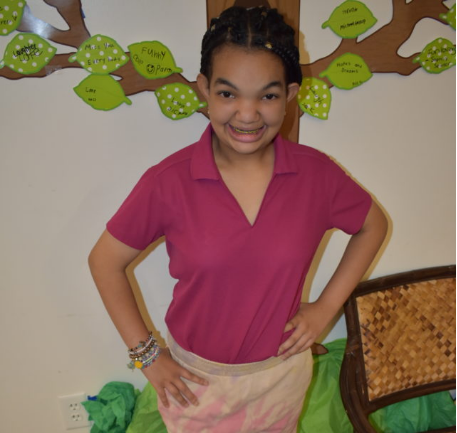
Willette Treadway, 14, was bullied at the district school she attended from kindergarten through sixth grade. Now attending North Florida School of Special Education on a Family Empowerment Scholarship for Students with Unique Abilities, she is thriving academically and socially.
Willette Treadway wants to help.
She wants to help her classmates, teachers, and administrators at North Florida School of Special Education, where she is in the Secondary 3 classroom. She wants to help her family and friends.
She wants to help the homeless population in Jacksonville.
“One thing about me,” Willette said, “I like to help everybody.”
“She has a big heart,” said her mom, Lisa Diana.
Willette, 14, was diagnosed at 7 with an intellectual difference and language impairment, which are neurodevelopmental conditions that appear in early childhood. She is a high performer socially but a low performer cognitively, where according to her mom, Willette is in the second to fourth grade level range with math, reading and vocabulary.
She attended her district school from kindergarten through the sixth grade. And while Lisa said Willette did well with her Individual Education Plan, she felt Willette “wasn’t grasping the material.”
Searching for a school that better fit her daughter’s unique abilities, Lisa enrolled Willette in North Florida School of Special Education in Jacksonville for the 2021-22 school year. Willette attends the school assisted by the Family Empowerment Scholarship for Students with Unique Abilities, managed by Step Up For Students.
To continue reading, click here.
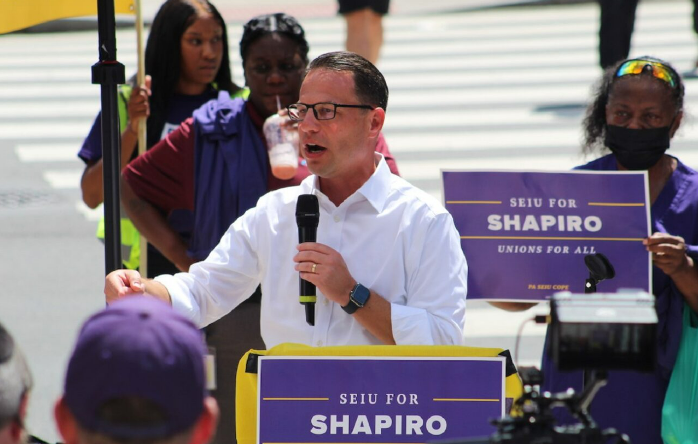
Service Employees International Union workers gathered in August to voice support for Pennsylvania Attorney General Josh Shapiro in his bid to become governor. PHOTO: Cory Sharber/WHYY
Editor’s note: This article appeared Tuesday on thecentersquare.com.
Support for more education funding isn’t a rarity among Democrats nationally, but Pennsylvania gubernatorial nominee Josh Shapiro is standing out – for his support of school choice.
On the campaign trail, Shapiro has emphasized his support for a “strong education system” and plans to make “critical investments” in teachers, buildings, and technology. Less emphasized until recent news stories has been his support for letting parents choose the schools their children attend.
“Josh believes parents deserve to be empowered to ensure their kids receive a good education and that every child has access to quality learning,” according to Shapiro’s campaign website. “That requires boosting funding for education and innovating to ensure children in our most challenged schools receive the education and care they deserve.”
While standard for Democratic candidates, what follows is less so.
“Josh favors adding choices for parents and educational opportunity for students and funding lifeline scholarships like those approved in other states and introduced in Pennsylvania,” his website reads.
That support aligns Shapiro with state Republicans, who advanced a school choice bill in the House in June and awaits Senate action.
The Center for Education Reform, a pro-school choice organization, called Shapiro’s support “an unprecedented move for a Democratic candidate for governor in Pennsylvania.”
“Whether if elected he would maintain that resolve remains to be seen,” Jeanne Allen, founder and CEO of the Center for Education Reform, said in a press release, “but we are incredibly optimistic when politicians recognize the importance of giving parents the right to direct the education of their children.”
To continue reading, click here.